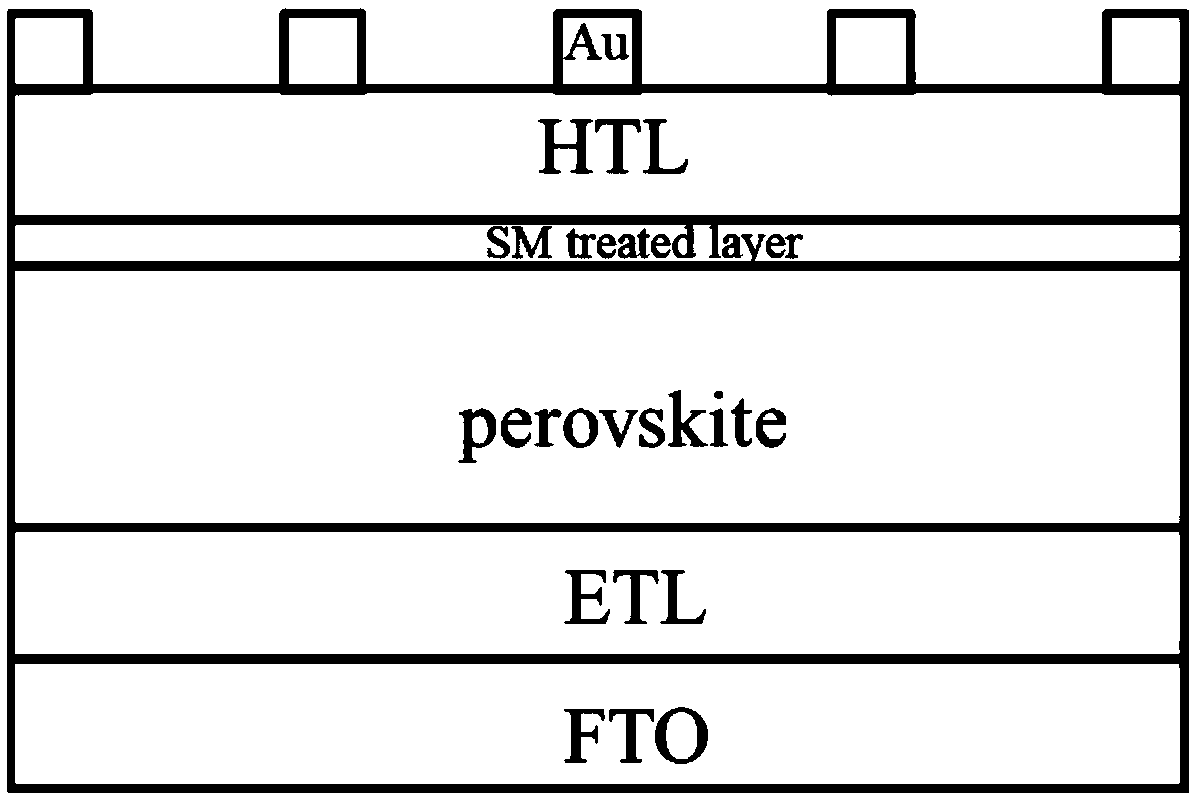Method for improving efficiency and stability of perovskite solar cell, and perovskite solar cell
A solar cell, perovskite technology, used in circuits, photovoltaic power generation, electrical components, etc.
- Summary
- Abstract
- Description
- Claims
- Application Information
AI Technical Summary
Problems solved by technology
Method used
Image
Examples
Embodiment 1
[0034] First, the FTO glass substrate was ultrasonically cleaned with acetone, isopropanol, and deionized water in sequence, followed by UV-ozone treatment for 20 minutes. Dilute 1 mL of titanium(IV) isopropoxide in 10 mL of ethanol, spin-coat on FTO at a rate of 6000 rpm for 30 s to prepare a dense layer (bl-TiO2), and then anneal at 450 ° C in air for 20 min. Dissolve commercially available paste (30NR-D, Dyesol) in ethanol (150 mg / mL) at 4000 rpm to prepare mesoporous TiO 2 (mp-TiO 2 ) layer, annealed in air at 450°C for 20 minutes to remove the organic part. Prepare the precursor solution (CsPbI 3 ) 0.05 (FAPbI 3 ) 0.79 (MAPbBr 3 ) 0.16, to deposit the perovskite layer in a two-step method, that is, drop 40 microliters of perovskite solution on the substrate, spin-coat at 1000rpm for 10s, and then spin-coat at 6000rpm for 20s, before the end of the second step of spin-coating 110 microliters of chlorobenzene solution containing α,β-COTh-OMeTAD (1mg / ml) was quickly ...
Embodiment 2
[0036] First, the FTO glass substrate was ultrasonically cleaned with acetone, isopropanol, and deionized water in sequence, followed by UV-ozone treatment for 20 minutes. Dilute 1 mL of titanium(IV) isopropoxide in 10 mL of ethanol, spin-coat on FTO at a rate of 6000 rpm for 30 s to prepare a dense layer (bl-TiO2), and then anneal at 450 ° C in air for 20 min. Dissolve commercially available paste (30NR-D, Dyesol) in ethanol (150 mg / mL) at 4000 rpm to prepare mesoporous TiO 2 (mp-TiO 2 ) layer, annealed in air at 450°C for 20 minutes to remove the organic part. Prepare the precursor solution (CsPbI 3 ) 0.05 (FAPbI 3 ) 0.79 (MAPbBr 3 ) 0.16 , to deposit the perovskite layer in a two-step method, that is, drop 50 microliters of the perovskite solution on the substrate, spin-coat at 1000rpm for 10s, then spin-coat at 6000rpm for 20 seconds, and finish the spin-coating in the second step In the first 5 seconds, 100 microliters of CB solution containing α,β-COTh-OMeTAD (1m...
Embodiment 3
[0037] Embodiment 3 (comparative example)
[0038] This embodiment is a positive structure device without small molecule passivation. The specific method is as follows: firstly, the FTO glass substrate is ultrasonically cleaned with acetone, isopropanol, and deionized water in sequence, and then UV-ozone treatment is performed for 20 minutes. Dilute 1 mL of titanium(IV) isopropoxide in 10 mL of ethanol, spin-coat on FTO at a rate of 6000 rpm for 30 s to prepare a dense layer (bl-TiO2), and then anneal at 450 ° C in air for 20 min. Dissolve commercially available paste (30NR-D, Dyesol) in ethanol (150 mg / mL) at 4000 rpm to prepare mesoporous TiO 2 (mp-TiO 2 ) layer, annealed in air at 450°C for 20 minutes to remove the organic part. Prepare the precursor solution (CsPbI 3 ) 0.05 (FAPbI 3 ) 0.79 (MAPbBr 3 ) 0.16 , to deposit the perovskite layer in a two-step method, that is, drop the perovskite solution on the substrate, spin-coat at 1000rpm for 10s, and then spin-coat...
PUM
 Login to View More
Login to View More Abstract
Description
Claims
Application Information
 Login to View More
Login to View More - R&D
- Intellectual Property
- Life Sciences
- Materials
- Tech Scout
- Unparalleled Data Quality
- Higher Quality Content
- 60% Fewer Hallucinations
Browse by: Latest US Patents, China's latest patents, Technical Efficacy Thesaurus, Application Domain, Technology Topic, Popular Technical Reports.
© 2025 PatSnap. All rights reserved.Legal|Privacy policy|Modern Slavery Act Transparency Statement|Sitemap|About US| Contact US: help@patsnap.com



